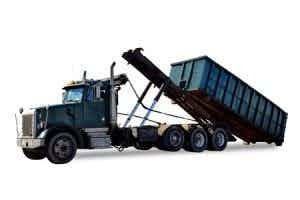In this case, the plaintiff was an employee of a recycling company who was injured on the job. The plaintiff was employed by the recycling company, and was working at the recycling yard when the accident occurred. On the date of the incident, the plaintiff’s supervisor was returning a roll-off dumpster that contained construction waste from a jobsite. The defendant unloaded the dumpster from the roll off truck, leaving it on the ground at the recycling yard. The roll off dumpster came to rest behind the dumpster truck with enough space for the plaintiff to walk between the rear of the roll-off dumpster truck and the roll off dumpster. The roll off truck bed was left in an elevated position and the truck’s engine was off as the defendant got into a case excavator and drove it to the rear of the roll off dumpster. The defendant then used the excavator to compact the construction waste that was in the roll off dumpster. While the defendant compacted the material, the roll off dumpster rolled forward and pinned the plaintiff between the roll off dumpster and the rear of the roll off dumpster truck, causing serious bodily injury and, eventually, the loss of one of the plaintiff’s limbs.

Question(s) For Expert Witness
1. Are you familiar with the design of roll off dumpsters? If so, please describe your experience. 2. Are there any types of breaking systems commercially available to prevent roll of dumpsters from moving after being offloaded to a job site?
Expert Witness Response E-008230
Roll-off containers are loaded and unloaded by means of specialized trucks. When the truck raises its hydraulically operated bed, the roll-off container rolls off of the bed. A cable is used to slowly lower the container. The truck can employ either a winch system or a hook-lift system. This sounds like a winch system. If the roll off is already on the ground, nothing from the winch system is holding it in place, so there is no braking or constraint system there. Wheel brakes are not a standard item on these units. Such things can be fabricated upon request, but if motion is a concern, using wheel chocks would be a more usual practice. Company and site safety rules as well as ANSI and OSHA regulations would have to be studied, as well as a study of visibility in the area made to determine whether or not the plaintiff could have been seen by the excavator operator and vice versa.
About the author
Joseph O'Neill
Joe has extensive experience in online journalism and technical writing across a range of legal topics, including personal injury, meidcal malpractice, mass torts, consumer litigation, commercial litigation, and more. Joe spent close to six years working at Expert Institute, finishing up his role here as Director of Marketing. He has considerable knowledge across an array of legal topics pertaining to expert witnesses. Currently, Joe servces as Owner and Demand Generation Consultant at LightSail Consulting.


